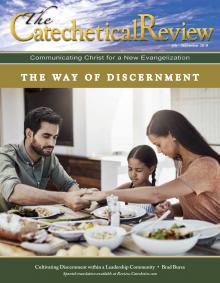“Mom, what’s that?” a little girl in the grocery store unabashedly asked as I walked past them in the produce aisle. Slightly embarrassed at her daughter’s rather loud and candid question, her mother simply and timidly responded “She’s a lady who loves Jesus.” I smiled at both mother and daughter and gave a little wave as I kept on in pursuit of the items on my list. In living my call to consecrated religious life over the past thirteen years, there have been plenty of experiences similar to this and I am sure that every sister has a supply of her own. Humorous as they may be, still they point to a sad reality that consecrated religious life is not as visible or fostered as it was in decades past and that the simplistic answer may have been the extent of that mother’s knowledge of the reality of this state in life. There was a time when most young people were exposed to sisters in the classroom, parish, or even in the family, but those days are gone. Most knowledge of religious life comes rather from movies like “The Sound of Music” or “Sister Act,” but the life of consecration has a depth and beauty worth studying and sharing with a generation that tends to long for more and settle for less. Throughout Salvation History, God has called men and women to follow him in the consecrated life. They have borne witness to the Gospel by living heaven on earth. In this way, they have revealed the providence of God in every age through their trust and their loving service to their brothers and sisters in need. From the earliest days, God called individuals to himself, as with the desert fathers, but that expression of single-hearted following of Christ eventually flowered into individuals living a dedicated life in community. Founders and foundresses responded to the needs of each particular time and established religious institutes within which members consecrated themselves to God through vowing the Evangelical Counsels, living in community, and serving according to their particular situation in apostolates such as health care, education, and care for the poor and needy of every condition. God’s call goes forth even today inviting young people to forsake the promises of the world for the sake of embracing his eternal promises. Vowing to live poverty, chastity, and obedience in a world that exalts material goods, sexual license, and individualism is counter-cultural to say the least, but it is a path worth discerning and a journey worth taking. Catechists have a particular role to play in assisting young people to encounter the truth and beauty of a call to be consecrated to God through the profession of the evangelical counsels through education and exposure. While the General Directory for Catechesis instructs that “every means should be used to encourage vocations to the priesthood, and to the different forms of consecration to God in religious and apostolic life and to awaken special missionary vocations,”[1] it is essential to remember that God is the source of every vocation. The role of the catechist is to propose to students that such a particular vocation is not just in the movies and that there is a real possibility that they could be called and ought to learn to listen to the gentle voice of the Good Shepherd.
The rest of this online article is available for current Guild members.
This article is from The Catechetical Review (Online Edition ISSN 2379-6324) and may be copied for catechetical purposes only. It may not be reprinted in another published work without the permission of The Catechetical Review by contacting [email protected]




